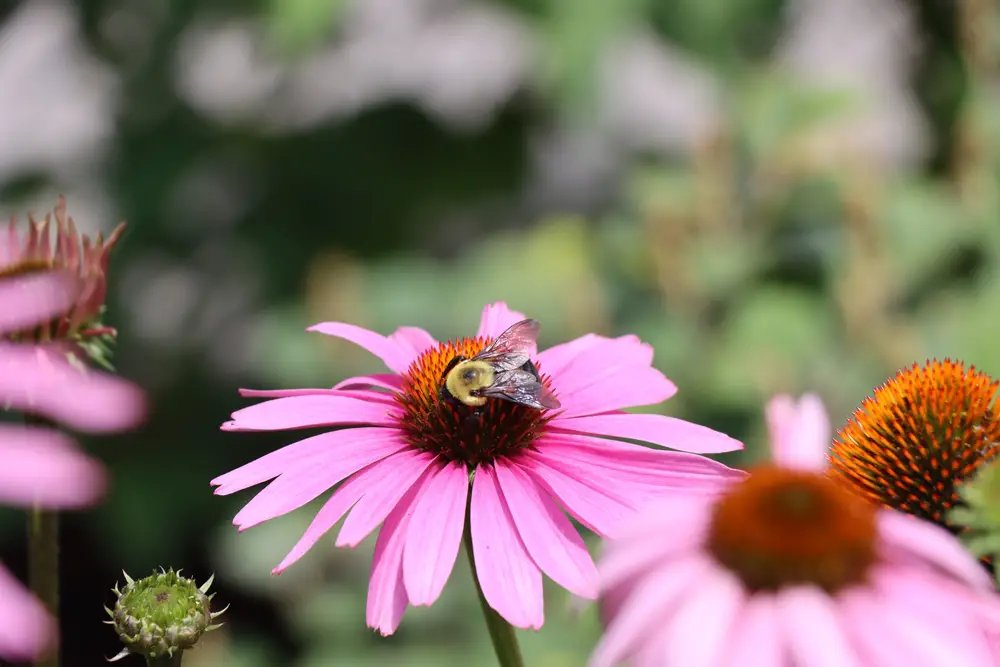I’m sure you’re familiar with the idea of a bee buzzing between flowers, collecting pollen and nectar. But do they eat them? Just what do bees eat anyway?
Bees eat pollen, nectar, and honey. They eat bee bread as well, which is made from pollen, nectar, and saliva. Some young bees also eat royal jelly from the nurse bees caring for them.
What Do Bees Eat?
Bees have a natural attraction to flowers. There are certain species like foxglove, calendula, lavender, and coneflowers that they’re really fond of, as well as colors in the blue, green, yellow, and purple spectrums.
Bees are fond of flowers because they produce pollen, one of their primary food sources. Pollen is a powdery, yellow substance the male part of flowers produces for reproduction.
Bees also drink nectar from flowers (an excellent source of carbohydrates). What’s lovely about nectar is researchers believe plants produce it purely as a reward to pollinators for helping them to reproduce by spreading pollen around.
Bees also make and eat bee bread. Bee bread is a “bee-made” substance consisting of pollen, nectar, and saliva. Older females make bee bread, which is capped in empty honeycomb cells and is an integral part of the diet of younger bees.
Do Bees Eat Honey?
I’ve met many people who assume honey is merely a by-product bees don’t use. It’s easy to think this when we see beekeepers harvesting pound after pound of honey and selling it for human consumption.
But bees produced and used honey as food long before humans realized its benefits. Honey provides bees with essential carbohydrates and sugars. They require these things to give them the energy they need for foraging.
How Much Do Bees Eat?
Bumblebees need to eat often. One study showed that a bumblebee queen might rest for between 30 and 45 minutes before needing to search for food again. That’s because these creatures expend a lot of energy when flying around since their bodies are quite weighty.
That said, they can survive for up to 24 hours without food.
In the case of honey bees, I think you’ll be surprised at just how much they need to consume every day. According to experts, a single honey bee that measures, on average, around 15 mm needs around 11 milligrams of sugar every day. That works out to approximately 22 microliters of nectar or sugar syrup.
But What About In Winter When There Aren’t Many Flowers?
You’ve likely noticed an abundance of bees in the spring and summer. But in winter, they’re unable to fly because the temperature is too low and conditions are often too wet.
In addition, most plants bloom in the spring and summer. There are some winter flowering plants, but not nearly enough to meet the needs of hungry bees.
For honey bees, winter means huddling together in the hive and sharing body heat. It also means eating from the honey they’ve been storing over the warmer months within the honeycomb. Each cell is filled with honey and sealed with beeswax (another natural product bees make). Over winter, there should be enough for the colony to survive.
However, for newly established colonies or those with large numbers, the honey stores may run out before winter is over. Many new beekeepers find this out the hard way as they’ll take more than their share of honey, not leaving the bees with enough.
If bees don’t have enough honey to see them through the colder months, there’s a serious risk of the colony dying off.
What Young Bees Eat
Honey bees live in huge colonies that can number tens of thousands. Three types of bees make up these colonies: sterile female workers, male drones, and a single fertile queen. The queen can lay up to one million eggs in her lifetime. Some of these will fight to become the new queen.
All bee larvae eat royal jelly. Nurses (workers responsible for raising the young) secrete this substance from glands in their heads. It’s made from simple sugars, water, proteins, and various vitamins.
However, not all bee larvae will live off this for long. In most cases, they’ll only feed on royal jelly for the first few days of life. After this, worker and drone larvae will switch to honey and bee bread, which is also the main part of the diet of adults.
A select few female larvae are chosen to be raised as potential queens, and their diet consists only of royal jelly.
In the case of most bee species, though, queens will lay their eggs in a solitary nest and collect nectar and pollen to feed their young. The bumblebee is a ground-nesting species, and the queen will hide out in her underground burrow over winter with her eggs.
When spring comes, she’s one of the first bees to emerge, and she’ll search for food for her larvae which will hatch imminently. Once she’s gathered nectar, she’ll store it in nectar pots and feed this to her young.
The carpenter bee, just like the honey bee, can make bee bread by regurgitating pollen and nectar. This is the primary part of the larval diet and is similar to many other bee species, including sweat bees.
How You Can Help Bees With Food
As I discussed earlier, bees store honey so they have a food source during winter. But sometimes, the colony simply can’t make enough to survive. For beekeepers, this can mean the life or death of the hive, so they must have a backup plan.
However, taking care of your local bee population’s nutritional needs isn’t just the responsibility of apiarists (beekeepers). We can all do our part to ensure bees have all the food sources they need.
Plant Bee-Friendly Flowers
Bee-friendly flowers are flowers that naturally attract bees. There are plenty to choose from, but some of the best include:
- Marigolds
- Lavender
- Basil
- Rosehip
- Calendula
- Foxgloves
- Fruit trees (including cherry, apple, pear, and plum)
- Zinnia
- Coneflower
- Allium
- Catmint
- Honeysuckle
- Crocus
It’s important to only plant native plants as bees are more likely to be drawn to them compared to exotic species.
Not only is this vital in ensuring good pollination within the local ecosystem, but it’s a great way to provide bees with all the food they need. Imagine everyone planting just a few bee-friendly flowers in our backyards; the difference would be massive.
Provide Them With Sugar Water
If you’re a beekeeper, you’ll probably be familiar with providing food supplements to your colony. You can typically do this by offering sugar water, and it’s effortless to make.
But this isn’t limited to those with a hive or two in their backyard. Anyone can leave out sugar water as an alternative food for bees, especially when natural food sources are low.
I’d always recommend using white sugar, as some other types can be detrimental to the health of the bees.
To make sugar water for bees, mix equal parts sugar and hot water and stir until the sugar is completely dissolved. Let the mixture cool down before leaving it in an open container for the bees.
That said, in the winter, many people recommend upping the sugar content as this replaces any lost sugar and honey.
For this, you will need to first make a sugar solution containing two parts sugar and one part water. You can then add this to a separate mixture using a 4:3 sugar and water ratio. Once you mix everything, you’ll need to boil the mixture to 238ºF (114.44ºC) so the sugar completely melts.
Again, allowing the mixture to cool before offering it to the bees is vital. This is a standard method among beekeepers when food sources run worryingly low in winter.

